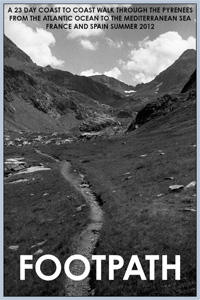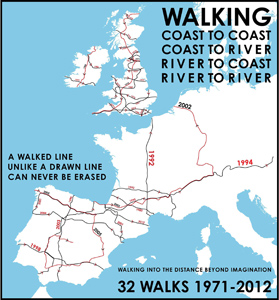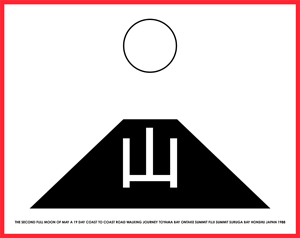Hamish Fulton – passing by
The spirit of Zen in Contemporary Art
Laurent Buffet

Since the 1950s, a period in which Zen Buddhism started to reach the West, a significant number of artists that we would soon call « contemporary », to distinguish them from « modern » artists of previous generations, have found and important source of inspiration in this spirituality. The section « the spirit of Zen in contemporary art » proposes to tell this story through the example of major artists. We start this month with Hamish Fulton.
Hamish Fulton – passing by
The work of Hamish Fulton lies first of all in the walks that, the artist has realised throughout the world, since the beginning of the 70s, and then in the artworks that bear witness to the walks, based on a now famous formula « No walk, no work ». Unlike Richard Long, who also, walking in the countryside, made lines and circles by trampling or by accumulation of stones, Fulton's marks blend in with those of the men and the flocks who follow the same paths as him. In this case, the absence of visibility of tracks requires another form of mediation to evoke the walks, which largely fall upon the written accounts. The many mediums used by the artist (books, photographs, texts, paintings, wall murals, etc) all have the purpose of relating the itineraries, but by means of narrations that hide more than they reveal of the experience they point to : « blind » accounts , a term we use for windows or for walls, that, however, don't owe their opacity to a surplus of presence but, on the contrary, to their extreme conciseness.
Most of Fulton's artworks include short phrases, preceded by a title which indicates , according to a variable order : the year, the period, the duration, the length, the itinerary, the place of the walk. The same title, depending on its occurrence, may be followed by a different text like « THE PILGRIMS WAY » which in a 1975 publication is documented by a brief note : « 1971 / 10 DAYS IN APRIL -A 165 MILES WALK / ENGLAND ; whereas a more detailed version appeared in a 1990 publication where the text is this time printed next to the photograph « 1971 / A HOLLOW LANE ON THE NORTH DOWNS / ANCIENT PATHS FORMING A ROUTE BETWEEN WINCHESTER AND CANTERBURY / 10 DAYS IN APRIL A 165 MILES WALK » Rather than « accounts » or « micro-accounts » may be we should talk about « narrative sketches » to evoke the fragmented, succinct and often allusive character of these texts. An obvious disproportion governs the relationship between their diegetic contents and the length of time and the geographic scope of the action – involving a variety of events which are also important – and which these contents should represent.

Such disproportion also characterises Fulton's photographs, which are not there to represent the landscapes walked through, but to represent the experience of walking. To understand the unique status of these images, the presence of text is necessary : the texts give temporal bearings which encourage us to read them as moments in a much longer process, the walks sometimes taking place over several weeks. Some patterns in particular bring to light the deliberately incomplete role of the image. Roads, footpaths, lanes - always very present in Fulton's work – whilst being obvious representations of walking - can also be seen as segments of space induced by the limits of the photographic medium. Indeed, the lines delineated on the ground by walking routes, being impossible to represent in their entirety, unless by an aerial view inaccessible to a walker, their presence in the image is the manifest sign of their own fragmented reality. In other words, just as photography fixes the moment of a length of time, it delimits a section of space of which walking routes strongly reveal the fragmented character. In this way the artist reminds us that the experience of walking goes beyong the framework of representation – and, as a result, his work is in the realm of the invisible.

Fulton sometimes notes down events that occur during his walks in the countryside : the passage of a cloud, the song of a bird, the gurgling of a stream, etc. The artist thus composes sensory lists that give a picture of his intense presence to the world around him. Such a usage of words reminds us of the art of Haïku, not only because of the concise form of the use of language but also because of the nature of the phenomena that these words evoke, phenomena marked by the seal of impermanence. Considering the work of Fulton, we think of Basho, even more than the English romanticism of William Wordsworth.
Just as the artist's body appears in none of the photos, relegated to an out-of-shot position, the « I » is absent from all of his texts. This absence is a way of consecrating the countryside, whilst refering to certain Buddhist principles. It is an expression of the vacuity of the subject of the walk who observes the appearance and disappearance of natural phenomena as the expression of this same vacuity. « The essential thing is the spiritual relation with nature. » affirms Fulton. According to Buddhist thought, realising vacuity, is also realising the link of interdependence which is between all phenomena : without their own substance, beings build their existence from mutual interactions. Walking in thecountry, the artist himself becomes an element amongst the elements, a being amongst the natural beings. Fulton's artworks remind us of the famous maxim of the Heart Sutra « Emptiness is form and form is emptiness ».

In the practice of Zen, we realise vacuity through concentration which leads to the gradual exhaustion of mental activity. Fulton's work bears witness to this meditative experience. In a book like « Only art resulting from the experience of individual walks » the expression « no thought » comes back significantly many times ; concerning protocols such as ; walking barefoot around his tent, making a determined number of steps on some rocks or on concrete etc. The artist explains in an interview : « During a walk, we go through different staes of mind, and as time goes by, I realise I tend to try to get rid of my excess of habitual thought ».
In summary, the walker's accounts prove to be as elusive as the tracks of his footsteps on the ground : whilst the latter are destined to disappear as soon as they appear, the former have no other goal but to evoke the silent communion of man and nature – blind accounts, because they are focused on the interior light of an experience without words.






